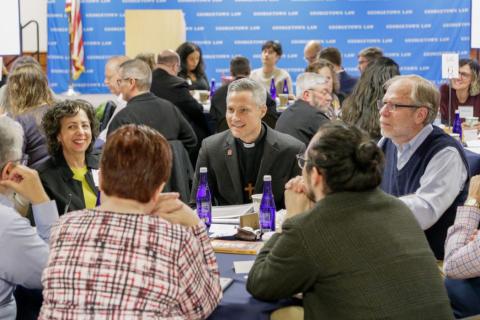“Some people are still reluctant to get together, while others think that the pandemic is practically over. How can I build a bridge with friends from both sides?” M. V.

The first thing that can be said about your question is that it is the right question! — “How can I build a bridge?” One thing that is so clear about this pandemic is that there are radically different ideas among people about what is happening, what the reasons for its happening are, and what the best solutions are.
As long as people hold such varying opinions and a lack of clarity accompanies a spirit of public panic, it seems unrealistic to insist that harmony among people must depend on everyone’s agreeing on these matters. The pursuit of unity must consist, instead, in doing one’s best to build bridges, as you put it so well.
The first step in building bridges is attempting to understand the other and refraining from arbitrarily assigning motives.
For example, it is tempting for vaccinated persons to assume that the unvaccinated simply don’t care about the welfare of others, but for many unvaccinated persons, this is not the case. Some have concluded instead that universal vaccination is bad policy during a pandemic, and many have also observed a high number of adverse reactions to current vaccines compared to those used in the past.
On the other hand, some balk at masks and vaccines and accuse those advocating both as intruders on individual rights, while failing to acknowledge that individual rights should never be the decisive determinant of what I choose to do or not to do for the sake of both self and others.
In decisions about masking and social distancing, some may be motivated primarily by fear of infection, while others may be motivated primarily by the social costs of alienation, masking and restrictions on movements.
A given individual’s convictions may lie anywhere along the spectrum described here, or they may involve still other concerns. It is crucial, first of all, to make the effort to understand the underlying reasons for the others’ positions rather than simply branding them as either unduly rigid, unduly permissive or uncharitable.
The second step is engaging others in discussion and finding values that we all hold in common. Even within the bewildering array of positions and solutions, it seems that most people do want some form of loving contact with one another.
Most want to protect themselves and their children not only from viral infection but also from isolation. Most people want an enjoyment of ordered freedom that allows the individual to flourish while also protecting the common good. And most people want to take in as much relevant information as possible in order to make the best decisions possible.
These are a lot of things in common. On this basis, it should be possible for people on different sides of an issue to come together at least to acknowledge the goals that both already seek. Each should be able to express not only desired outcomes but also their reasons for objecting to specific solutions, and at least be heard by the other with respect.
And each should be willing to consider possible solutions that may differ from their own initial proposals, such as coming together outdoors, connecting virtually with some who may be unable or uncomfortable meeting in person, and so forth.
Finally, as they seek to come together on the foundation of such shared values, all who wish to build bridges must be ready to accept that doing will involve some risk. As the differing positions show vividly, possible infection is not the only risk to be considered. The risks to freedom, the quality of social interaction and mental health are also quite real.
When people find themselves on different sides of an issue or proposal, both sides must be willing to risk something in order to come together as one. Conversely, both sides should be able to feel acknowledged and accommodated without being called upon to sacrifice every single value that they may think is at stake.
When the way has been carefully prepared for coming together, by gathering either virtually or physically, carefully taking into account the most deeply held convictions and aspirations of all, it is almost certain that no one will have achieved their “ideal” result, and no one will be confident of having avoided all risk. But the best ideal should be unity rather than anyone’s individual preferences.
A willingness to lay down oneself for others, imitating Jesus, will never be entirely risk free.













